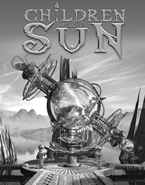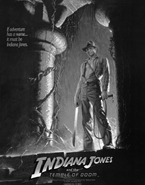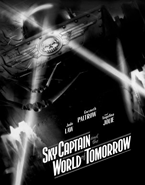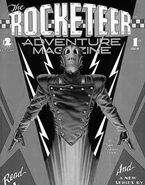 THE GATEHOUSE
THE GATEHOUSE
“The darker, dirtier side”
By N. Ottens (12 February 2008)
Amidst the panoply of curious variations upon the concept of steampunk, ranging from “clockpunk” for Renaissance Era science fiction to “atomicpunk” for tales set in an anachronistic early-Cold War period, dieselpunk stands out as perhaps the sole candidate for becoming a true genre in its own right. Where steampunk itself originated during the 1980s as a tongue in cheek variant of cyberpunk, “dieselpunk” has come gradually into prominence after being introduced by Children of the Sun game designer Lewis Pollak in 2001, who initially coined the phrase to describe only a “darker, dirtier side of steampunk.” The genre may be similar to steampunk in that it colonizes the past with technologies more sophisticated than feasible at the time, yet is informed by cyberpunk sensibilities, incorporating neo-noir elements and being specifically characterized by the rise of petroleum power and technocratic perception—hence, according to Pollak, it should be understood as a “continuum between steampunk and cyberpunk.”¹
Influences
Typically set in a post-steampunk era, dieselpunk draws inspiration from that period's literature. Like steampunk looks to the past through nineteenth-century science fiction in the form of scientific romances by H.G. Wells, Mark Twain and the Voyages Extraordinaires of Jules Verne, dieselpunk indulges in the wide variety of genre fiction published from the 1920s through the 1950s in pulp magazines. Though many classic science fiction and crime novels were originally serialized in such publications, pulp is commonly associated with adventure fiction in the vein of Indiana Jones—influenced, in turn, by turn-of-the-century penny dreadfuls, also published on cheap wooden pulp paper.
The 1981 Indiana Jones film Raiders of the Lost Ark could be considered one of the earliest dieselpunk works of fiction, seeking to recreate the plots and looks stereotypical of pre-World War II adventure stories.2 Quintessential dieselpunk elements featured in the film, ranging from the plot’s heavily reliance on adventure and heroism to its depiction of Nazis possessing bizarre technologies and engrossed in esoterica and mysticism, reappear in later dieselpunk works such as the 1999 The Mummy, which also throws archaeologists in an environment of mystery and deadly machines, and Mike Mignola's Hellboy, of which the first film adaption depicts Nazis equally obsessed with the occult.
Mid-century pulp not only inspires the plots of dieselpunk fiction; Sky Captain and the World of Tomorrow director Kerry Conran sought to evoke the futuristic spirit of pulp hero tales as well as Golden Age comic books.3 Conran cited both German Expressionism, particularly the films of Fritz Lang, and the work of delineator Hugh Ferriss, whose drawings of immense buildings seem to overshadow the human individual as if embodying the rise of technocratic attitudes, as having influenced his film stylistically.4 Director Tim Burton of Batman Returns similarly acknowledges Ferriss’ urban inhumanism in his 1992 film, the angular building designs and severe-looking city squares of Gotham City evoking the loom and menace present in Metropolis. Burton’s work is thus considered a modern attempt to capture the essence of German Expressionism.
Anachronistic Pulp
In spite of the similarities between dieselpunk and the pulp stories upon which it is typically based, dieselpunk is no retro-futurism. Like steampunk transports modern-day automata and perceptions into the nineteenth-century and is thus different from Victorian-Edwardian scientific romances and Voyages Extraordinaires, dieselpunk colonizes the past with technologies more, and more aggressively developed than in the real world and with sensibilities characteristic of cyberpunk and dystopian fiction. Like steampunk exists within the framework of speculative fiction, of which the origins date back to the pioneering works of Jules Verne, H.G. Wells, Mark Twain and Mary Shelley, dieselpunk draws its inspiration from pre- and post-World War II pulp magazines and the technologies of war devised or nearly produced during the last phases of that war.
Dieselpunk video games enthusiastically embrace the experimental and sometimes ridiculous weapons of war developed in Nazi-Germany as the Second World War neared its conclusion. Because of these technologies, Germany is able to prolong the war effort in the alternate histories of games as Dream Pod 9’s Gear Krieg, Ubisoft's Blazing Angels II and Digital Reality’s War Front: Turning Point. Each feature futuristic Nazi technologies based upon real-world inventions such as the Messerschmitt Me 262 and the ambiguous German nuclear weapons project. Similar technologies are featured in the 2002 game Iron Storm and Fallout series, though both are set decades after World War II came to an end in the real world, the former in a diesel-powered post-apocalyptic dystopia; the latter in a world where the First World War is still being fought with the advent of nuclear weapons threatening to disturb the balance of power. German science is typically depicted to have progressed its experimentation with biotechnology, sparking off a genetic revolution of cloning and organ harvesting and producing cyborg supersoldiers in games like Return to Castle Wolfenstein and ÜberSoldier.
A New Genre?
Unlike dieselpunk fiction set during the Second World War, comic book-like hero tales set either prior to or after the war usually appear more optimistic. In the world of Sky Captain and the World of Tomorrow, there is no sign of economic recession and the spirit of the Roaring Twenties very much persisted. With no Great Depression to halt industrial progress, the Jazz Age never quite came to an end, nor did the era’s sense of modernity. Everything seemed feasible through modern technology—a perception revived during the early years of the Cold War, characterized by incredible progress and prosperity yet plagued by Red Scare and nuclear paranoia. Amidst uncertainty, comic book heroes inspired by pulp characters like Buck Rogers and Flash Gordon provide hope and adventure in films such as The Rocketeer and The Iron Giant. Tom Floyd advertizes his Captain Spectre as “the midwest’s own pulp hero”5 and Joshua Dysart's Captain Gravity seems yet further indication of the revived appreciation for classic comic heroes besides the emergence of more flawed and troubled incarnations of traditional heroes such as Batman and the Iron Man.
Many works of fiction share the characteristics of dieselpunk, though perhaps because the bulk of said fiction is comprised of comic books and video games, the genre is yet to find widespread acceptance as being more than a variation upon steampunk. Though dieselpunk has much in common with steampunk, most notably the “anachronization” of the past, the genre is generally more dystopian and negative about period sensibilities. Where steampunk seeks to greaten appreciation for the individualism of steam-powered technology and embraces Victorian Era sensibilities, dieselpunk shreds not from depicting the ill effects of progress and those who cannot live it. Dieselpunk characters tend to originate from lower social classes than their steampunk contemporaries, often seeming less in control of the plot than steampunk protagonists.
1. M. Bruno, “Interview: Misguided Games’ Lewis Pollak, on Children,” GamingReport.com (2001)
2. Indiana Jones.com, “Making Raiders of the Lost Ark,” Lucasfilm Ltd. (2003) (Retrieved through Internet Archive.)
3. W. Claw, “Sky’s Not the Limit: Kerry Conran on being a pioneer of Tomorrow,” FilmFreaks.net (2004)
4. H. Knowles, “More on Sky Captain & the World of Tomorrow,” Ain't It Cool News (2004)
5. T. Floyd, Captain Spectre And The Lightning Legion
Please select one of the titles listed below to proceed to your article of choice.
• “The darker, dirtier side,” by N. Ottens (2008)
In which we seek to define the genre of dieselpunk by studying its major influences and proposing several characteristics typical of dieselpunk fiction.• “Quintessential Dieselpunk,” by N. Ottens (2008)
In which we further scrutinize the features of the genre by examining a number of its quintessential works of fiction.• “Two Flavors of Dieselpunk,” by N. Ottens (2008)
In which we introduce the two proposed categories of dieselpunk: the optimistic “Ottensian” and the dark, sometimes post-apocalyptic “Piecraftian”.• “What’s Biopunk?,” by N. Ottens (2008)
In which we discuss the history and characteristics of the proposed sub-genre of biopunk to ascertain whether it is a separate genre.


Children of the Sun, the first, self-proclaimed, dieselpunk video game. Misguided Games (2002)

Indiana Jones, a modern attempt at recreating the pulp action hero.

Sky Captain and the World of Tomorrow, the model dieselpunk film. Paramount Pictures (2004)

Man and machine conjoined, in Return to Castle Wolfenstein, Activision (2001)

Dave Stevens, Rocketeer Adventure Magazine #1, Comico Comics (1988); Atomicpunk?